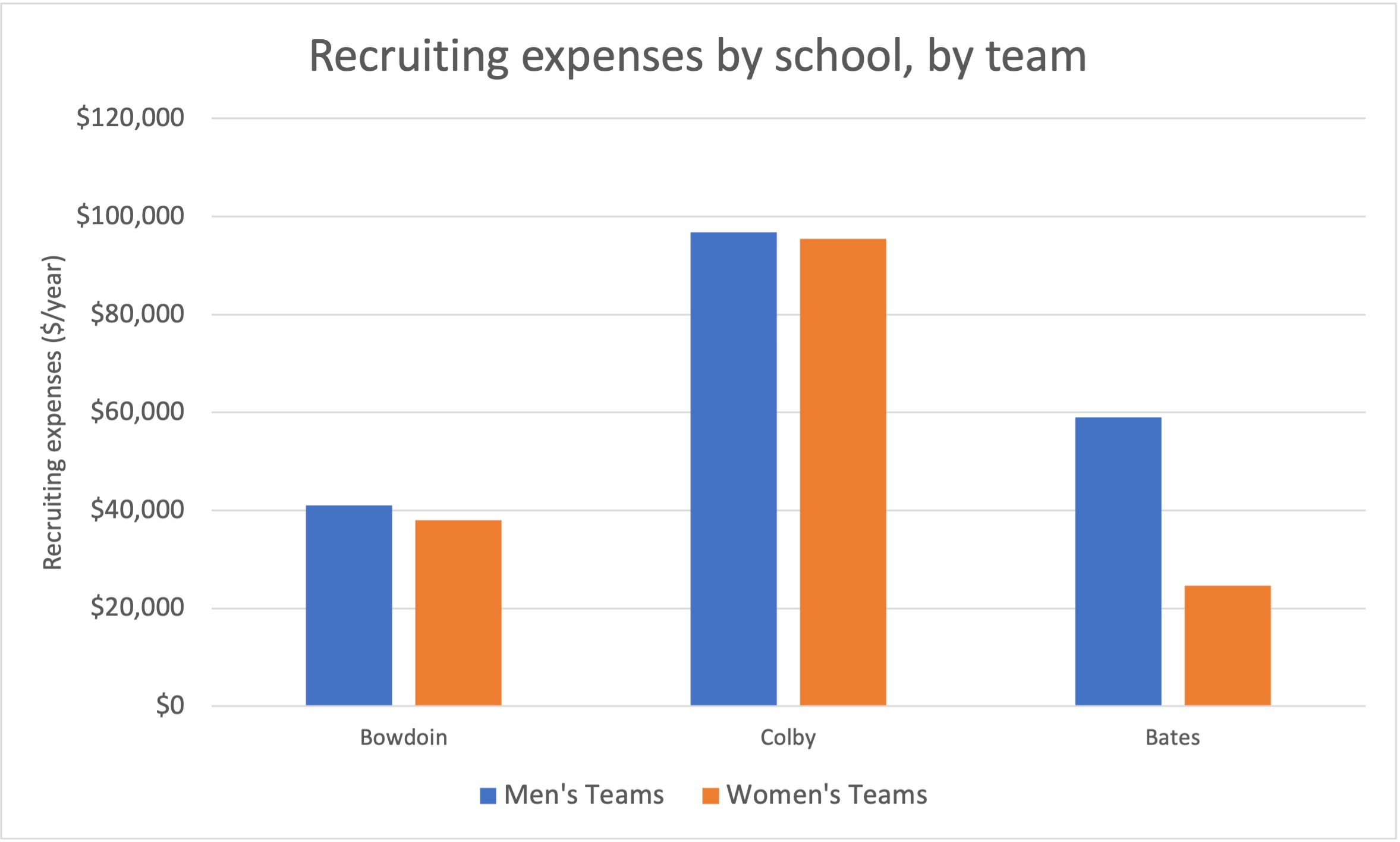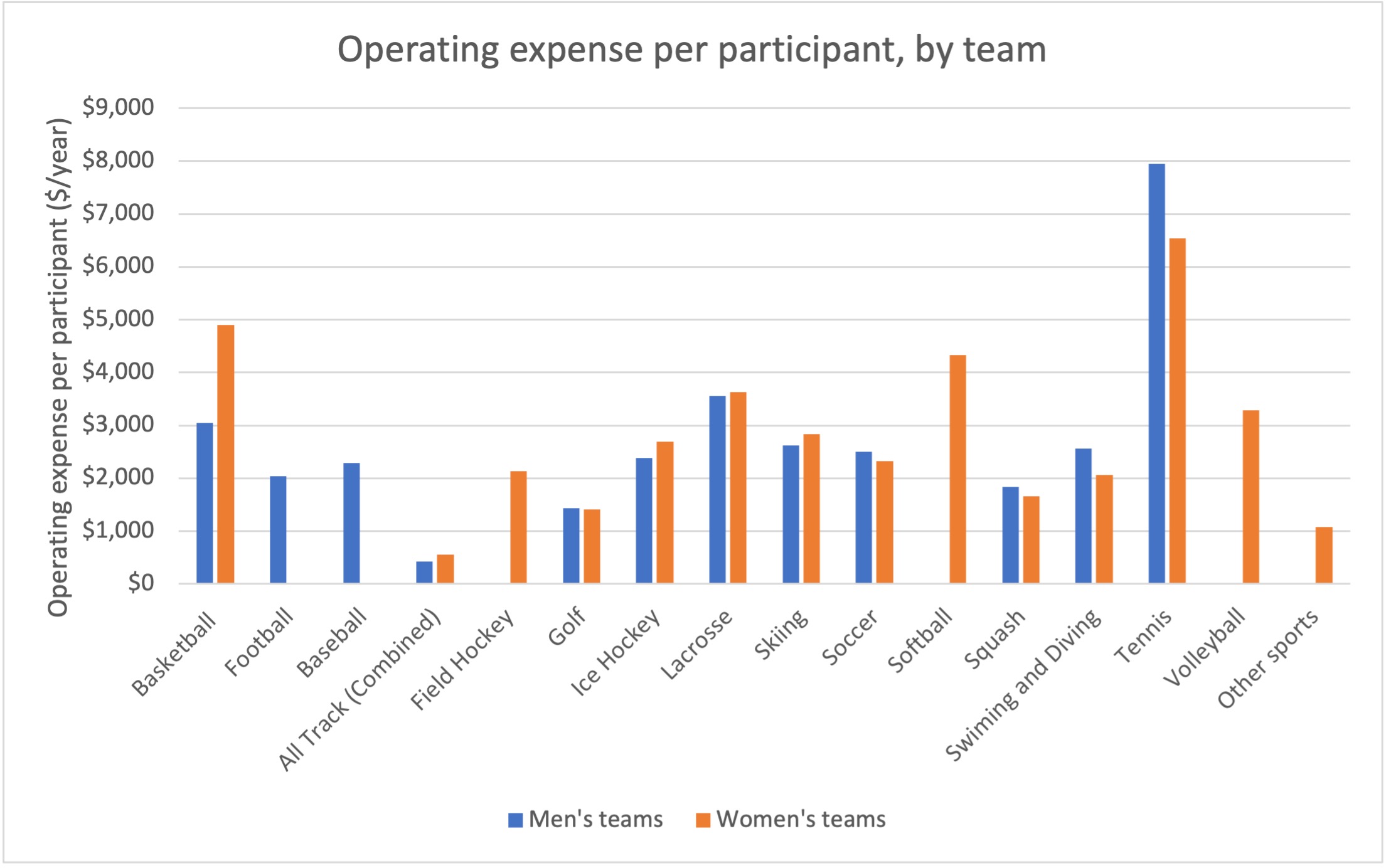Athletics spending from 2018-2019 school year shows pay gap between women’s teams’ and men’s teams’ coaches
May 6, 2021
Every September, collegiate athletic departments around the country are required by the U.S. Department of Education and the Equity in Athletics Disclosure Act (EADA) to report their athletic expenses and net revenues, as well as the demographics of their teams, for the previous academic year. While the EADA report from 2019-20 has been delayed due to the COVID-19 pandemic, data from 2018-19 provides insight into how Bowdoin’s athletic department secures funds and spends its money.
EADA reports are separated into three sections: personnel, expenses and revenues. At Bowdoin in 2018-19, the athletic department’s expenses were equal to its revenue of $12,823,173.
A majority of the $12,823,173 earned, and subsequently spent, by the athletic department in 2018-19 was sourced from the College itself, as it is every year.
“Our athletic department does not make money for the College,” Ashmead White Director of Athletics Tim Ryan said in a Zoom interview with the Orient. “Supporting collegiate athletics is a decision that the College has made in terms of the overall planning and budgeting for the student experience on campus, and the vast percentage of what is referred to as revenue in the reporting is simply the College funding the operations of the athletic department.”
 Nimra Siddiqui
Nimra SiddiquiHowever, some funds were sourced from alumni, most of which were donated to the Polar Bear Athletic Fund. The Fund raises about $150,000 each year and supports all of the athletic programs offered at the College, but alumni can also donate directly to certain programs.
“We don’t do a lot of soliciting for funding [for individual programs] because we’re really fortunate to have our programs be funded by the College,” Ryan said. “So, the majority of the fundraising that takes place is general fundraising through the Polar Bear Athletic Fund to help support all of our programs.”
Expenses in the EADA report are more complex than revenue. Operating expenses, as defined by the report, are game day expenses. At Bowdoin, this mostly consists of travel expenditures.
“Travel drives the bulk of the [operating] expenses for our programs, and that is impacted by the number of students who may happen to participate within a particular program,” Ryan said. “The majority of our travel is centered in and around New England, which helps to limit those expenses, but they do end up being considerable.”
More broadly, total expenses encompass coaches’ salaries and facilities upkeep, as well as operating expenses.
While each team’s budget varied and the operating expenses per player per team ranged from $431 (men’s track and field/cross country) to almost $8,000 (men’s tennis), the average of the department’s total expenses per player essentially evened out across gender, with an average of $6,794 spent per male athlete and $6,665 spent per female athlete.
“By and large, across gender, in terms of the students that we’re supporting within the department, it’s not intentional to have it be exact because there are various factors that come into play with the different sports that we support,” Ryan said. “But it is certainly something that we’re mindful of to manage the allocation of resources across all of our teams.”
 Nimra Siddiqui
Nimra SiddiquiEqual allocation, however, does not extend to the salaries of coaching positions. In 2018-19, all head coaches of men’s teams were men, and half of the head coaches of women’s teams were men. During that academic year, head coaches of men’s teams were paid an average of $52,809, while head coaches of women’s teams were paid an average of $48,746.
If these are standardized to Full Time Equivalents (FTE)—scaling the institutional salary to what it would be if the coaches were full-time workers—the pay gap reaches about $10,000. In 2018-19, men’s teams’ head coaches were paid $92,919 on average as FTEs and women’s teams’ head coaches were paid $82,421 on average as FTEs.
“Our salary structure is based upon the experience level of the people who we bring into the various coaching positions that we have and their contributions to the College,” Ryan said. “Over time, as there’s turnover and staffing, I think the disparity … in terms of salaries for head coaches will deviate in either direction.”
The pay gap as FTE between men’s and women’s coaches at Bowdoin was almost half of the pay gaps as FTE at Colby and Bates, both of which were about $20,000 in 2018-19.
“[The pay gap] is a really important issue that we’ve been monitoring for quite some time,” Ryan said. “It’s not a new conversation within our department, but the salary decisions are really based upon the experience level of people who we bring into our programs.”
 Nimra Siddiqui
Nimra SiddiquiAt Bowdoin, the pay gap across men’s and women’s teams continues to a lesser extent for assistant coaches. Men’s team assistant coaches were paid $72,692 as FTEs and women’s team assistant coaches were paid $67,169 as FTEs.
“We are really internally focused in terms of the resources that we allocate to support our programs here at Bowdoin, more so than making comparisons with our peers,” Ryan said. “But going back to when Tim Foster was the dean of students and in my early days as the director of athletics … this has been something that the College has paid attention to and, as I mentioned before, it’s an important issue.”
See the data:
Bowdoin College EADA Report 2018-2019
Comparison of Bowdoin College, Colby College and Bates College EADA Reports 2018-2019


Comments
Before submitting a comment, please review our comment policy. Some key points from the policy: